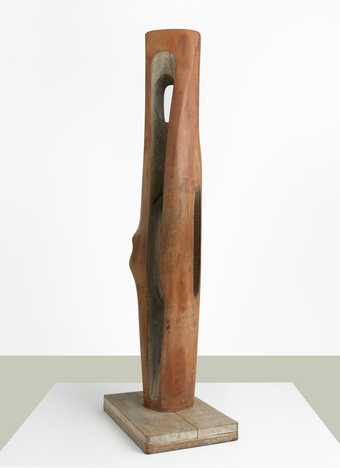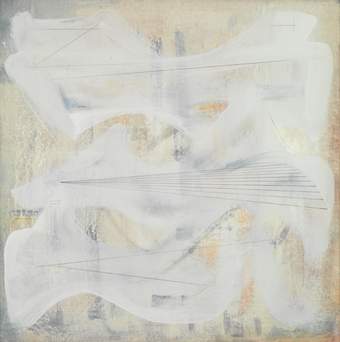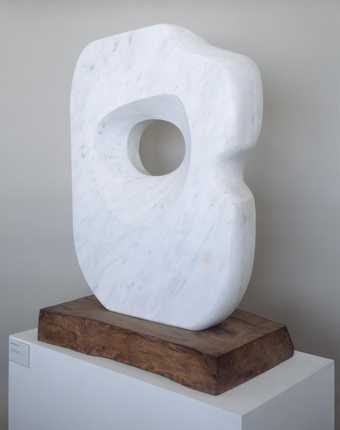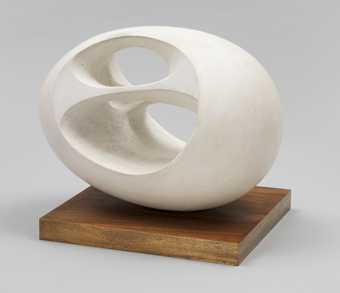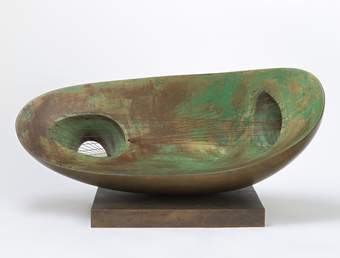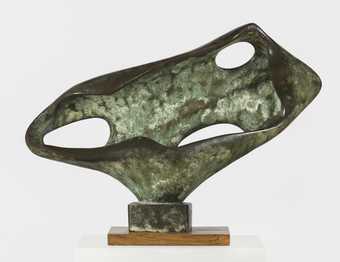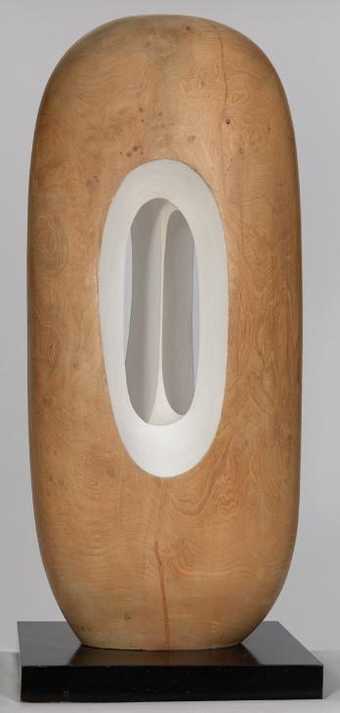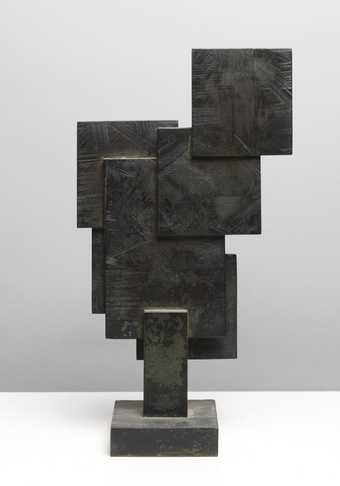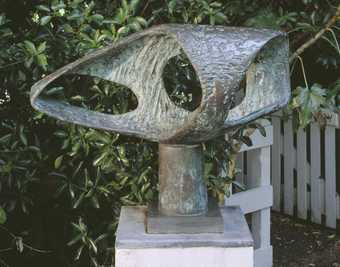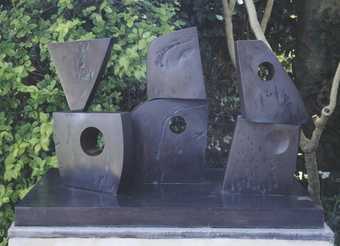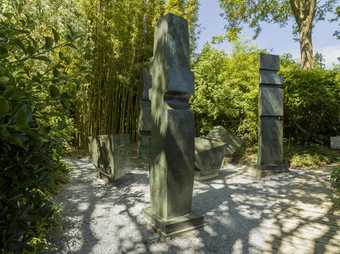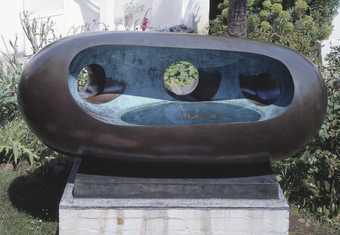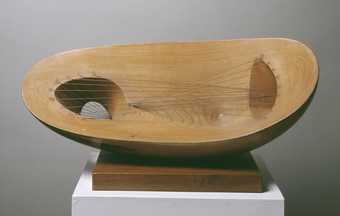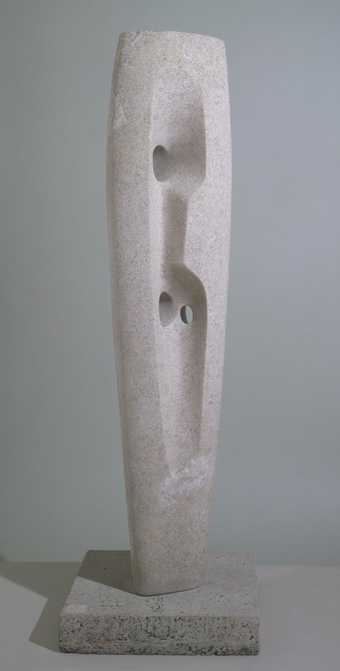
Not on display
- Artist
- Dame Barbara Hepworth 1903–1975
- Medium
- Bronze on wooden base
- Dimensions
- Object: 902 × 597 × 673 mm
- Collection
- Tate
- Acquisition
- Purchased 1960
- Reference
- T00353
Display caption
Hepworth settled in St Ives during the Second World War. Inspired by the local landscape, she began to sculpt her responses to the natural forms around her. Trevalgan is the name of a hill near her home. There, she wrote, ‘the cliffs divide as they touch the sea facing west. At this point, facing the setting sun across the Atlantic, where sky and sea blend with hills and rocks, the forms seem to enfold the watcher and lift him towards the sky.’ The sculpture is not a literal representation of the divided cliffs, but a personal expression of Hepworth’s physical and spiritual encounter with nature.
Gallery label, May 2007
Does this text contain inaccurate information or language that you feel we should improve or change? We would like to hear from you.
Catalogue entry
Dame Barbara Hepworth
1903-1975
T00353 Curved Form (Trevalgan) 1956
BH 213; cast 5/6
Bronze 902 x 597 x 673 (35 1/2 x 23 1/2 x 26 1/2) on teak base 70 x 500 x 535 (2 3/4 x 19 5/8 x 21); weight 160 kg.
Cast numerals on upper edge of left side '5/6'
Purchased from the artist 1960
Exhibited (ý = unidentified cast, ü = other cast):
Recent Works by Barbara Hepworth, Gimpel Fils, June 1956 (12ý)
Barbara Hepworth: Sculpture, Paintings, Drawings, Martha Jackson Gallery, New York, Dec. 1956-Jan. 1957 (no number)
Sculpture 1850-1950, London County Council Exhibition, Holland Park, May-Sept. 1957 (15ý, repr.)
Het Beeld in de Stad
(Sculpture in the Town), Antwerp, June-Aug. 1958 (32, pl.6)
Pittsburgh Bicentennial International Exhibition of Contemporary Painting and Sculpture, Carnegie Institute, Pittsburgh, Dec. 1958-Feb. 1959 (207ü, as Travalgan)
Modern Sculpture, Leeds City Art Gallery, Oct.-Nov. 1958 (32, pl.6)
Paintings by Francis Bacon, Paintings & Etchings by S.W. Hayter, Sculpture & Drawings by Barbara Hepworth, V Bienal do Museu de Arte Moderna São Paolo, Sept.-Dec. 1959 (14ý, repr.)
Hepworth, Galerie Chalette, New York, Oct.-Nov. 1959 (15ü, repr.)
Barbara Hepworth, BC tour of South America, Comisión National de Bellas Artes, Montevideo, Apr.-May 1960, Museo Nacional de Bellas Artes, Buenos Aires, May-June, Instituto de Arte Moderno, Santiago, Sept.-Oct., Museo de Bellas Artes, Viña del Mar (Chile), Oct., Museo de Bellas Artes, Caracas, Nov. 1960 (13, repr.)
Recent British Sculpture: Robert Adams, Kenneth Armitage, Reg Butler, Lynn Chadwick, Hubert Dalwood, Barbara Hepworth, Bernard Meadows, Henry Moore, Eduardo Paolozzi, BC tour of Canada, New Zealand, Australia, Japan and Hong Kong 1961-4, National Gallery of Canada, Ottawa, April-June 1961, Montreal Museum of Fine Arts, Aug.-Sept., Winnipeg Art Gallery, Sept.-Oct., Norman Mckenzie Art Gallery, Regina College, Nov., Art Gallery of Toronto, Jan.-Feb. 1962, Public Library and Art Museum, London, Ontario, Feb.-March, Vancouver Art Gallery, March-April, Auckland Institute and Museum, July, Dominion Museum, Wellington, Aug.-Sept., Otago Museum, Dunedin, Oct., Canterbury Museum, Christchurch, Nov.-Dec. 1962, West Australia Art Gallery, Perth, Jan.-Feb. 1963, National Gallery of Victoria, Melborne, July-Aug., Art Gallery of New South Wales, Sydney, Sept.-Oct., Queensland Art Gallery, Brisbane, Nov.-Dec. 1963, Newcastle War Memorial Cultural Centre, Jan. 1964, Albert Hall, Canberra, Feb., Bridgestone Art Gallery, Tokyo and other Japanese venues, including Museum of Modern Art, Kyoto, July-Aug., City Hall Art Gallery, Hong Kong, Aug.-Sept. 1964 (33ü, repr.)
Barbara Hepworth: An Exhibition of Sculpture from 1952-1962, Whitechapel Art Gallery, May-June 1962 (21ý, repr.)
Contemporary British Painting and Sculpture, Albright-Knox Art Gallery, Buffalo, N.Y., Oct.-Nov. 1964 (20ü, as Curved Form)
Nine Living British Sculptors, Lalit Kala Akademi/BC tour of India 1965-6, Lalit Kala Akademi Gallery, Delhi, Nov.-Dec. 1965, Government College of Arts and Crafts, Calcutta, Dec., Rajaji Hall, Madras, Jan. 1966, Jehangir Art Gallery, Bombay, Feb. 1966 (24ü, repr.)
Barbara Hepworth, BC European tour, 1964-6, Kunstforeningen, Copenhagen, Sept.-Oct. 1964 (10), Moderna Museet, Stockholm, Nov.-Dec. 1964 (11, repr.), Ateneum, Helsinki, Jan.-Feb. 1965 (10, repr.), Utstilling I Kunstnernes Hus, Oslo, March (10, repr.), Rietveld Pavilion, Rijksmuseum Kröller-Müller, Otterlo, May-July (14), Kunsthalle Basel, Sept.-Oct. (9), Galleria Civica d'Arte Moderna, Turin, Oct.-Nov. 1965 (11, repr.), Badischer Kunstverein, Karlsruhe, Feb.-March 1966 (9), Museum Folkwang, Essen, April-June 1966 (9ü)
British Sculpture 1952-1962, Brooke Park Gallery, Londonderry, April 1967, Ulster Museum, Belfast, May-June 1967 (22ý, repr.)
Britisk Skulptur 1952-62, BC tour of Norway, Stavanger Sept. 1967, Bergen, Sept.-Oct., Trondheim, Oct.-Nov., Tromso, Nov. (22ü, repr.)
Barbara Hepworth, Tate Gallery, April-May 1968 (79)
Collectors Choice, Gimpel Weitzenhoffer, March 1969 (38ü)
Eight British Sculptors, BC exhibition, United Arab Republic, 1969 (18ü)
Yedi Ingiliz Heykeltrasi (Seven British Sculptors): Robert Adams, Kenneth Armitage, Lynn Chadwick, Hubert Dalwood, Barbara Hepworth, Bernard Meadows, Henry Moore, BC & Turco-British Association tour, 1970, Ankara, Istanbul (18ü, repr.)
Barbara Hepworth, Plymouth City Art Gallery, June-Aug. 1970 (24ý)
Barbara Hepworth Exhibition 1970, Hakone Open-Air Museum, Japan, June-Sept. 1970 (6, repr. in col.)
A Right to Vote, Westminster Hall, Palace of Westminster, July 1978 (no cat.)
The Pier Gallery, Stromness Orkney, Tate Gallery, Sept.-Oct. 1978, Aberdeen Art Gallery and Museum, Nov. 1978-Jan. 1979, Glasgow Art Gallery and Museum, Jan.-Feb. 1979 (24, repr. p.36)
Barbara Hepworth: A Retrospective, Tate Gallery Liverpool, Sept.-Dec. 1994, Yale Center for British Art, New Haven, Feb.-April 1995, Art Gallery of Ontario, Toronto, May-Aug. (53, repr. in col. p.103)
Literature:
Tate Gallery Report 1960-1, 1961, pp.21-2
J.P. Hodin, Barbara Hepworth, 1961, pp.20, 169 no.213, repr.
Mary Chamot, Dennis Farr and Martin Butlin, Tate Gallery: The Modern British Paintings, Drawings and Sculpture, I, 1964, p.279
Usab, 'British Sculptress', Modern Review, Delhi, vol.119, no.4, April 1966, pp.299-300
Barbara Hepworth: A Pictorial Autobiography, 1970, New ed. 1978, p.75
Frank Davis, 'Substance and Shadow', Art and Antique Weekly, 14 June 1975, pp.16-17
Barbara Hepworth: Late Works, exh. cat., Edinburgh Festival Society, 1976, unpag.
David Fraser Jenkins, Barbara Hepworth: A Guide to the Tate Gallery Collection at London and St Ives, Cornwall, 1982, p.17, repr. p.30
Alan G. Wilkinson, 'Cornwall and the Sculpture of Landscape: 1939-1975' in Penelope Curtis and Alan G. Wilkinson, Barbara Hepworth: A Retrospective, exh. cat., Tate Gallery Liverpool 1994, pp.99, 102-4
Sally Festing, Barbara Hepworth: A Life of Forms, 1995, pp.225-6
Reproduced:
Albright Art Gallery Catalogue of Acquisitions 1957-8, 1959 (47)
A.M. Hammacher, Barbara Hepworth, 1959, pl.29
Michael Shepherd, Barbara Hepworth, 1963, front cover
Owen Broughton, 'The Technique of Recent British Sculpture', Bulletin of the National Gallery of South Australia, Adelaide, April 1963 (unpag., installation)
Elise Grilli, 'Modern British Sculpture', Japan Times, 30 May 1964
Denis Farr, British Sculpture since 1945, 1965, pl.12
'Artrends', Contemporary Art Bulletin, no.4, July-Oct. 1965
'Sculpture from Britain', The Statesman, Calcutta, 16 Dec. 1965
'Rare opportunity to see works of nine living British sculptors', Current, Bombay, 19 Feb. 1966
Jaywalker, 'British Sculptors: An Actual Journey', Financial Express, Bombay, Feb. 1966
A.M. Hammacher, Barbara Hepworth, 1968, rev. ed. 1987, p.128, pl.29
Judith Rich, 'Barbara Hepworth', Guardian, 17 Jan. 1973, p.8
The Pier Gallery, Stromness, Orkney, 1978, p.30
Michael Tucker, Dreaming with Open Eyes: The Shamanic Spirit in 20th Century Art and Culture, 1992, p.277
Agnes Allen, The Story of Sculpture, 1958, opposite p.193, pl.30
As a medium, bronze re-emerged within Barbara Hepworth's practice in 1956 with the making of Curved Form (Trevalgan)
specifically for casting. She had been trained in modelling at the Royal College, and at least one student work in bronze survives (Standing Woman, Right Hand Raised, 1925, no BH no.; repr. Post-War and Contemporary British Art, Christie's, 23 Oct. 1996, lot.41 repr. p.32), but in the 1920s she had eschewed the process as part of her commitment to a modernist perception of the technical honesty of carving. In the 1950s, the situation changed. The demand for Hepworth's work increased substantially as her reputation was secured and she recognised that bronzes were more likely to survive the pressures of the 'travelling circus' of exhibiting around the world (letter to Herbert Read, 29 Oct. 1961, Sir Herbert Read Archive, University of Victoria, B.C.). Metal sculpture was being made more generally, with iron rivalling bronze in the work of the younger generation of British sculptors, such as Kenneth Armitage, Reg Butler and Lynn Chadwick; their exhibition at the Venice Biennale in 1952, introduced by Herbert Read, met with critical success. The presiding presence of a work by Henry Moore outside the British pavilion raised complaints from Hepworth which Read met with the explanation: 'if you had had a large sculpture to balance Henry's that would be the ideal solution' (letter to Hepworth 6 Dec.1951, TGA 955, quoted in Penelope Curtis, 'The Artist in Post-War Britain' in Curtis and Wilkinson 1994, p.142). As Penelope Curtis has remarked (ibid.), this may be interpreted as encouragement towards the use of bronze which Moore had espoused with such critical and commercial success. It was not until 1956 that Hepworth followed suit, beginning with Curved Form (Trevalgan). Paradoxically, she subsequently found herself having to justify her use of bronze to Read. In so doing, she stressed the carving of the plaster which was then cast - as distinct from modelling in clay - and asserted that she endeavoured 'to remain constant to "truth to material"' (29 Oct. 1961, Sir Herbert Read Archive, University of Victoria, B.C.).
New materials facilitated Hepworth's development of a working method by which the conflict between carving and casting would be reconciled. At the same time as using sheet metal for sculptures such as Orpheus
(Tate Gallery T00955), she adopted expanded aluminium as the armature for plasters prepared for casting. Expanded aluminium is a tight mesh which is strong and flexible, and is produced in sheets which are easily cut up. It is responsive to manipulation, and provides an ideal key for plaster. For Hepworth's purposes, building up the plaster was swift by comparison to carving wood or stone. That this was the process used on Curved Form (Trevalgan)
has been confirmed by one of Hepworth's assistants at the time, the sculptor Brian Wall (interview with the author, 3 May 1996). The flexibility of the material allowed the application of curves to the sides and a twist to their alignment. While the sides remained close to the thickness of the aluminium, as is evident from their flat edges, more plaster was layered on the lower parts of the sculpture around the off-centre pierced hole. Hepworth later compared the whole process to 'covering the bones with skin and muscles' adding: 'But I build it up so that I can cut it. I like to carve the hard plaster surface' (Alan Bowness (ed.), The Complete Sculpture of Barbara Hepworth 1960-69, 1971, p.7).
The texture of the carving, in combination with that of the application of the plaster, is retained in the bronze of Curved Form (Trevalgan) . The treatment of the surface would become more highly wrought as Hepworth adjusted to the process. In addition, casting opened the possibility of colour. The brown-green patination chosen for Curved Form (Trevalgan)
was applied judiciously in response to the form; it anticipates the green which the artist favoured for most of her subsequent bronzes. The edition was made by a standard lost wax method at the Art Bronze Foundry in Fulham, which was the first of a number of founders with whom Hepworth placed work. Two bolts from the small opening in the underside of the sculpture hold it to the base; on other casts this was granite (for outdoor display) but the artist fitted a wooden base on acquisition by the Gallery. The bronze has been cleaned, and, but for a scratch to the back right edge, it remains in good condition (Tate Gallery Conservation Notes).
Curved Form (Trevalgan)
echoes the form of the wood carving of the previous year Curved Form (Delphi)
1955 (BH 199, Ulster Museum, Belfast, repr. Hodin 1961, pl.199. The latter had similarly raised sides, enclosing a hollowed out interior with an off-centre hole. Although the guarea wood necessitated more bulk - and part of the interior was strung - it is telling that the crucial step towards new materials and techniques undertaken in Curved Form (Trevalgan)
benefited from the guidance of a pre-conceived form.
If the vessel-like enclosure of both works reflected their respective methods of manufacture, Hepworth also drew attention to the relation to the landscape in her choice of subtitle. When she included Curved Form (Trevalgan)
in the exhibition Sculpture 1850-1950
(Holland Park, May-Sept. 1957) she wrote in the catalogue:
This 'Curved Form' was conceived standing on the hill called Trevalgan between St. Ives and Zennor where the land of Cornwall ends and the cliffs divide as they touch the sea facing west. At this point, facing the setting sun across the Atlantic, where sky and sea blend with hills and rocks, the forms seem to enfold the watcher and lift him towards the sky.
(Pictorial Autobiography, 1970, p.75)
This text might suggest a literal reading of the forms of the sculpture as echoing the division in the cliff. The similarity to Curved Form (Delphi)
encourages this, as the oracle at Delphi was associated with a cleft in the mountain. However, the suggestion of enfolding indicates a more complex response, which Hepworth enlarged upon when she told the Tate (15 May 1961, Tate Gallery Catalogue Files) that Trevalgan and Nanjizal (see Tate Gallery T00352) 'are Cornish place-names which inspired me to do the works. Trevalgan is a hill overlooking the Atlantic ... Both sculptures are really my sensations within
myself when resting in these two places'. The final qualification established the work as activated by the place rather than depicting it. The use of local names - Trevalgan is about two miles west of St Ives - in the titles of works from the early 1950s suggested a rooting in the locality. However, the association of her work with the landscape was more complex. In 1952, she wrote:
I was the figure in the landscape and every sculpture contained to a greater or lesser degree the ever-changing forms and contours embodying my own response to a given position in the landscape. What a different shape and 'being' one becomes lying on the sand with the sea almost above from when standing against the wind on a high sheer cliff with seabirds circling patterns below one; and again what a contrast between the form one feels within oneself sheltering near some great rocks or reclining in the sun on the grass-covered rocky shapes which make the double spiral of Pendour or Zennor Cove; this transformation of essential unity with land and seascape, which derives from all the sensibilities, was for me a voyage of exploration. There is no landscape without the human figure: it is impossible for me to contemplate pre-history in the abstract. Without the relationship of man and his land the mental image becomes a nightmare.
(Herbert Read, Barbara Hepworth: Carvings and Drawings, 1952, section 4)
These ideas, explored in the carvings of the 1940s, seem also to have infused Hepworth's bronzes of the late 1950s. What she termed 'a different shape or "being" ' was the result of an equation between body and landscape, an experience of immersion and identification through 'the form one feels within oneself'. This was an approach to the reconciliation of subject and abstraction in relation to landscape which Hepworth shared with others working in West Penwith, as demonstrated through the works and titles of Ben Nicholson and Peter Lanyon. In 1953, when Dudley Shaw Ashton made his film about Hepworth - with music by Priaulx Rainier - it was entitled Figure in Landscape.
Curved Form (Trevalgan)
was widely exhibited. A cast (1/6) was bought by the Albright (subsequently Albright-Knox) Art Gallery in Buffalo and submitted to the Pittsburgh International in 1958-9. In 1960, both the Tate and the British Council bought casts (5/6 and 4/6 respectively), the latter being exhibited around the world as a result. Another cast (3/6) is in the Pier Arts Centre, Stromness. In a curious incident, the last cast was stolen from the foundry and - on the assumption that it would be melted down - an additional cast (6/6) was taken in March 1960 (notes from a meeting between the artist and Kay and Peter Gimpel, 14-16 Jan. 1960, TGA 965 Hepworth Papers). The successful work was followed by closely related bronzes, such as Involute II, 1956 (Tate Gallery T03749) and, on a smaller scale, Corymb, 1959 (BH 270, Estate of the artist, repr. Curtis and Wilkinson 1994, p.148, no.62 [Tate Gallery L00940]).
Matthew Gale
March 1998
Explore
- abstraction(8,615)
-
- from recognisable sources(3,634)
-
- landscape(1,191)
- universal concepts(6,387)
-
- environment / nature(315)
- UK counties(19,585)
-
- Cornwall(1,034)
- England(19,202)
- England, South West(3,507)
- England, Southern(8,982)
- Trevalgan(1)
You might like
-
Dame Barbara Hepworth Figure (Nanjizal)
1958 -
Dame Barbara Hepworth Forms (West Penwith)
1958 -
Dame Barbara Hepworth Pierced Form
1963–4 -
Dame Barbara Hepworth Oval Sculpture (No. 2)
1943, cast 1958 -
Dame Barbara Hepworth Landscape Sculpture
1944, cast 1961 -
Dame Barbara Hepworth Sea Form (Porthmeor)
1958 -
Dame Barbara Hepworth Hollow Form with White
1965 -
Dame Barbara Hepworth Square Forms
1962 -
Dame Barbara Hepworth Bronze Form (Patmos)
1962–3, cast 1963 -
Dame Barbara Hepworth Six Forms (2 x 3)
1968 -
Dame Barbara Hepworth Vertical Form (St Ives)
1968, cast 1969 -
Dame Barbara Hepworth Conversation with Magic Stones
1973 -
Dame Barbara Hepworth River Form
1965 -
Dame Barbara Hepworth Landscape Sculpture
1944 -
Dame Barbara Hepworth Image
1951–2

